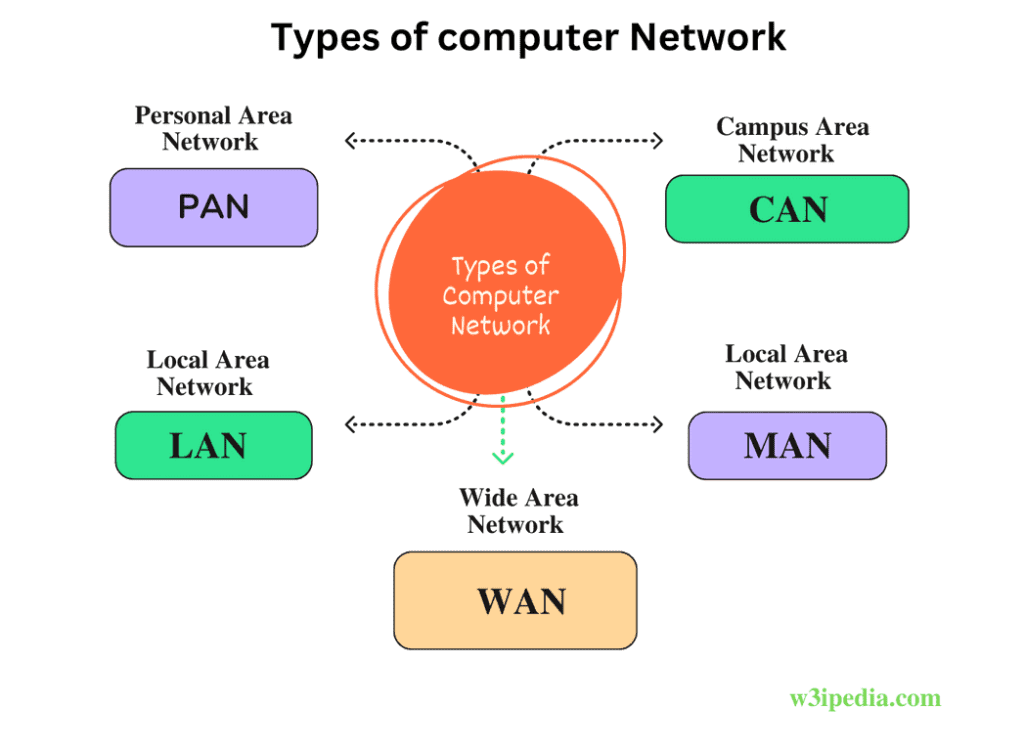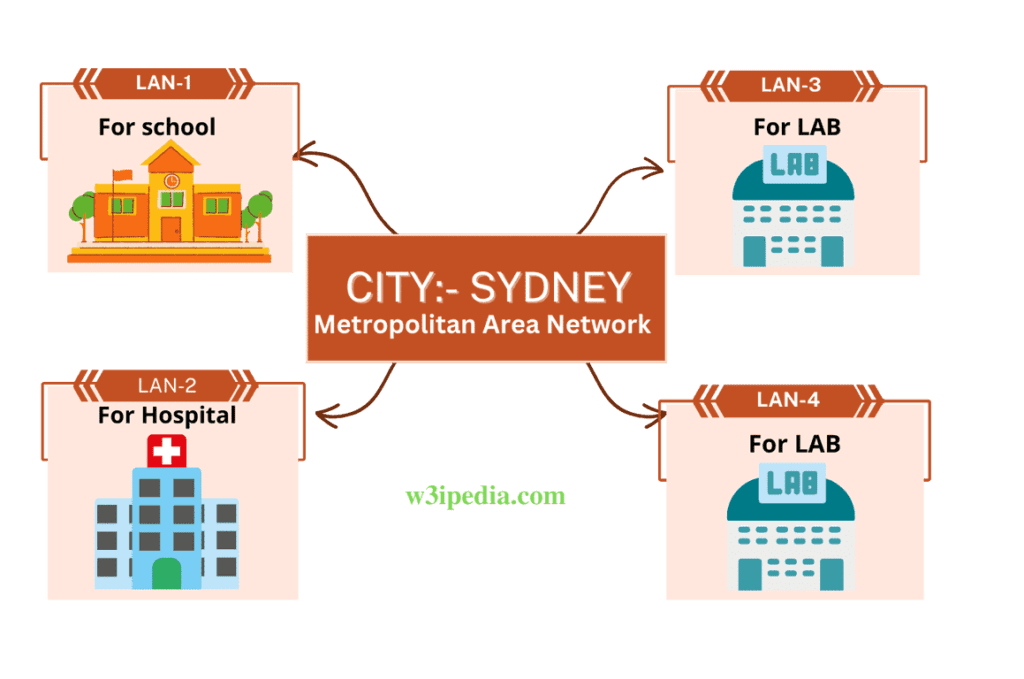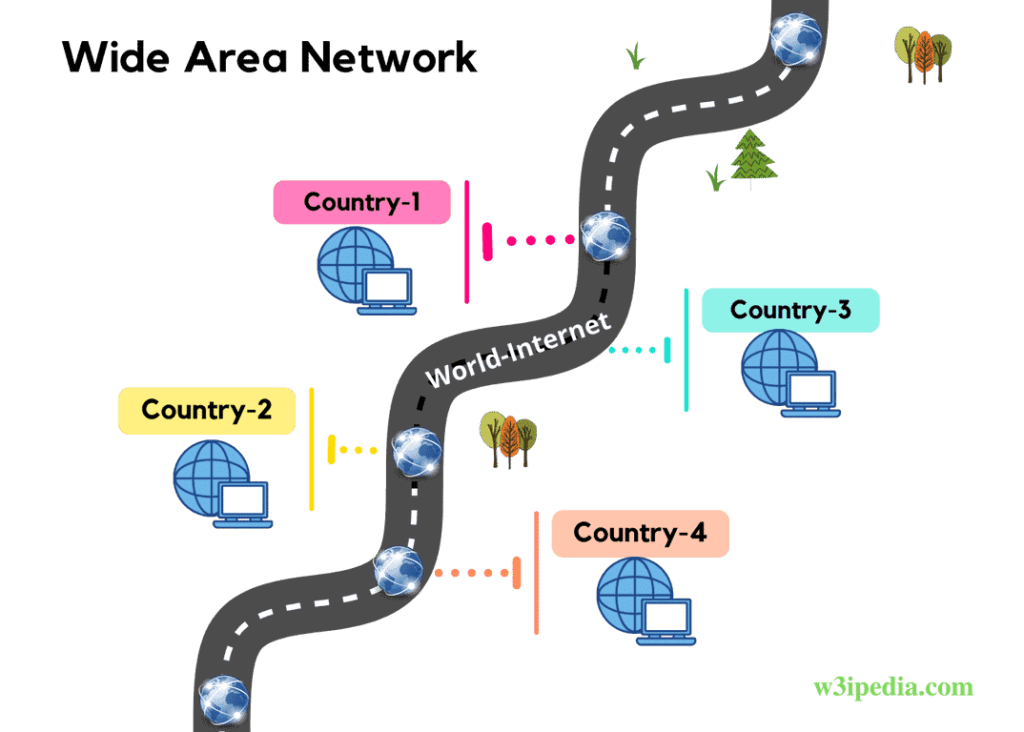This tutorial will explain each type of computer network so you can comprehend them. This is an important step, especially in light of competitive exams.
Technology took a giant leap forward in 1936 when the first computer was invented. However, it wasn’t until years later in 1969 that the first computer-to-computer link was established. It was this development that ultimately paved the way for the Internet-driven world we live in today.
Table of Contents
ToggleWhat is a computer network and explain?
It is a connection between two or more computers that share files and resources and allow communication.
Please click on the provided link if you want to learn more about computer networks or if you missed our previous post.
The number of devices, along with their spacing and distance from one another, determine the type of network. Based on geographic distance, computer networks are categorized into the following types:-

Personal Area Network (PAN)
It is a very small network used by a single user for personal use, it used Bluetooth and some time ago Infrared which had a range of more than about ten meters.
It also includes a Bluetooth keyboard, headphones, printer, TV remote, etc.

Campus Area Network (CAN)
If we use any network, wireless or LAN, only within a campus or a fixed campus, whether it be a school, college, university, or company, it must be within a single campus. When we use it, we will call it Campus Area Network.
For example, if an office is located in a building, the network system will be in the same location as the office where broadband will be established.
For as many users to easily use Wi-Fi or LAN cable a network will be developed and it will cover the entire campus area.

The term “campus area network” refers to any single fixed network that connects any campus.
- Technology: – Ethernet
- Range: 1 t 5 km
- Transmission speed: – high
- Area:- within the university or corporate offices
- Ownership: Private
- Maintenance:- Moderate
- Malfunction Rate: -Moderate
- Cost: – Moderate
Local Area Network (LAN)
This kind of network is popular and well-known. A local area network, or LAN, as its name suggests, links a collection of computers or other devices. Work in a limited physical location, such as a society, office, university, or school.

- Technology: – Ethernet
- Range: 1 t 5 km
- Transmission speed: – high
- Area:- within the university or corporate offices
- Ownership: Private
- Maintenance:- Moderate
- Malfunction Rate: -Moderate
- Cost: – Moderate
- Easy to design and troubleshoot.
- Bus ring topology is commonly used.
- Technology:- Ethernet and Wi-Fi
- Range: Up to 2 km
- Transmission speed: – Very high
- Area:- Inside the office building
- Ownership: Private
- Maintenance: – Easy
- Malfunction Rate: – Low
- Cost: – Low cost
Metropolitan Area Network (MAN)
MAN= consists of different Local Area Network
A metropolitan area network (MAN) is a huge computer network typically used for a city or large campus.
Its main purpose is to extend a Local Area Network and it is similar to a local area network but spread across a city or campus.
Multiple local area networks are connected to establish a metropolitan area network (MAN). Its size is between that of a wide area network and a local area network.
It is specially designed for high-speed connections.

Advantages of a metropolitan area network
- It is bigger than LAN.
- It transfers data at high speed.
- Any company can connect all its branches located in the same city.
- A MAN consists of different private LANs connected by cable and a router or gateway.
- It is economical due to the sharing of expensive resources by all branches of the company.
Disadvantages of Metropolitan Area Network
- Network installation is difficult and requires skilled personnel.
- Installation cost is very high.
Wide Area Network (WAN)
A wide area network is a huge computer network that covers a large geographic region, such as from one province to another province, state to another state, country to another country, or the entire world.
A very relevant example of a WAN network is the Internet. Thus we can say that the Internet is the largest WAN network. Many Local Area Networks (LANs) are connected to Metropolitan area Networks (MANs) to form Wide Area networks (WANs). A WAN spans a country or the globe. The coverage area of this network is more than all other networks.

- Wide Area Network>Local Area Network
- Wide Area Network>Metropolitan Area Network.
- So, WAN is Greater than All computer networks
A WAN can span a country, continent, or even the entire world. Long-distance data traffic requires people to connect to different countries with the help of a network.
To use a Wide Area Network (WAN), we can do the following transmission media:-
- Mobile Phone or telephone network.
- High speed, High Band Width, Leased Circuit.
- High-Speed Fiber Optic Cable.
- Micro Wave transmission
Advantages of Wide Area Network (WAN)
- A WAN is a global network since it has no geographic boundaries.
- Both private networks and public networks can be used to implement WAN.
- WAN supports international trade and international commerce.
Disadvantages of Wide Area Network (WAN)
- WAN is a vast and intricate network.
- It moves more slowly than LAN and MAN do.
- WAN security is not very good.
- Because we have to pay every time we transfer data, it is incredibly expensive.